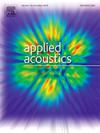Implementation of minimum output variance filtered reference least mean square algorithm with optimal time-varying penalty factor estimate to overcome output saturation
IF 3.4
2区 物理与天体物理
Q1 ACOUSTICS
引用次数: 0
Abstract
The minimum output variance filtered reference least mean square (MOV-FxLMS) algorithm can effectively prevent the instability of active noise control (ANC) systems caused by the output saturation of the secondary source. The penalty factor, a critical parameter in MOV-FxLMS algorithm, is usually determined by trial and error, and its inaccurate estimate degrades algorithm's performance. Previous studies prove that estimating the optimal penalty factor requires prior knowledge of the disturbance. In practice, the penalty factor varies with the acoustic environment and primary source. Hence, this paper proposes an optimal time-varying penalty factor estimate method, which can track the variation of the disturbance and primary noise and assist the MOV-FxLMS algorithm in achieving the optimal control with output constraint. Moreover, the proposed algorithm also efficiently reduces computations and storage capacity requirements compared to other algorithms. The numerical simulation not only demonstrates that the proposed algorithm can react to noise variations but also reduces the influence of uncorrelated signals at the error sensor. Furthermore, the real-time experiment on a noise duct demonstrates the effectiveness of the proposed algorithm for the output saturation problem, exhibiting practical significance.
求助全文
约1分钟内获得全文
求助全文
来源期刊

Applied Acoustics
物理-声学
CiteScore
7.40
自引率
11.80%
发文量
618
审稿时长
7.5 months
期刊介绍:
Since its launch in 1968, Applied Acoustics has been publishing high quality research papers providing state-of-the-art coverage of research findings for engineers and scientists involved in applications of acoustics in the widest sense.
Applied Acoustics looks not only at recent developments in the understanding of acoustics but also at ways of exploiting that understanding. The Journal aims to encourage the exchange of practical experience through publication and in so doing creates a fund of technological information that can be used for solving related problems. The presentation of information in graphical or tabular form is especially encouraged. If a report of a mathematical development is a necessary part of a paper it is important to ensure that it is there only as an integral part of a practical solution to a problem and is supported by data. Applied Acoustics encourages the exchange of practical experience in the following ways: • Complete Papers • Short Technical Notes • Review Articles; and thereby provides a wealth of technological information that can be used to solve related problems.
Manuscripts that address all fields of applications of acoustics ranging from medicine and NDT to the environment and buildings are welcome.
 求助内容:
求助内容: 应助结果提醒方式:
应助结果提醒方式:


